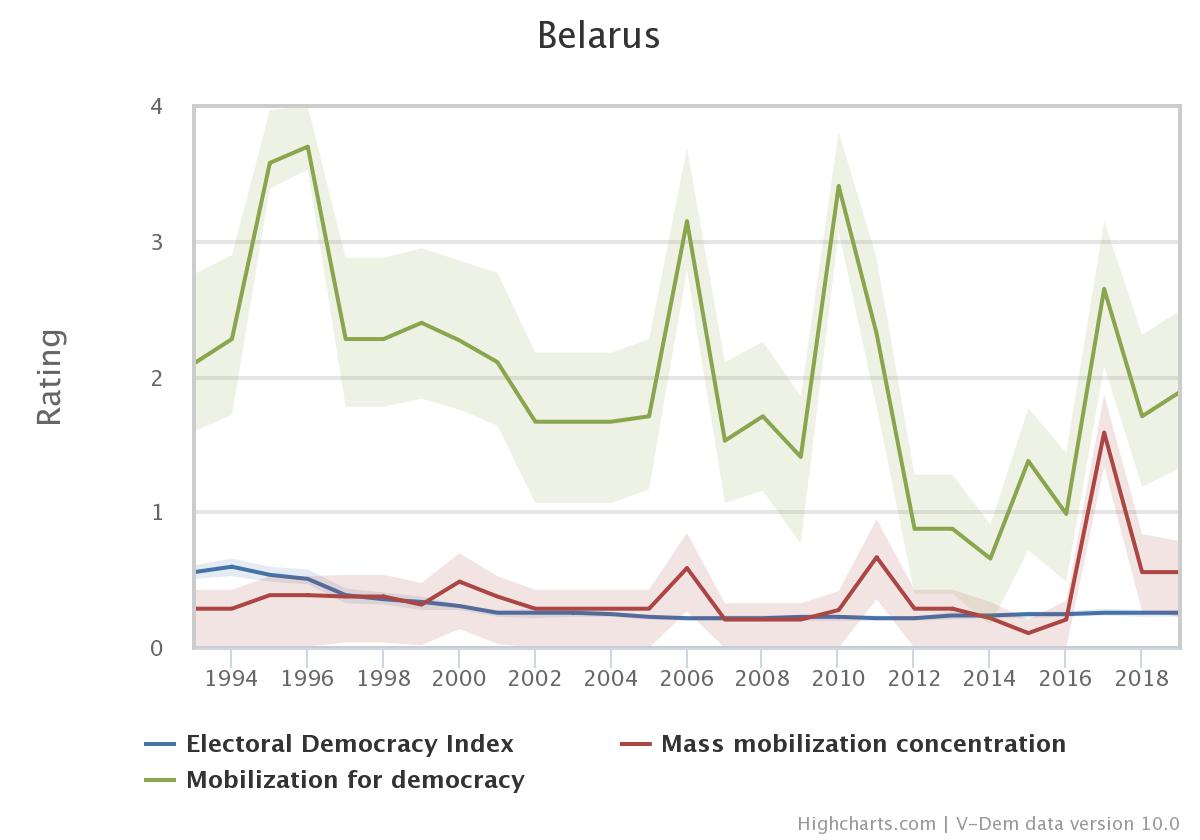Belarus: Is “Europe's Last Dictator” Tumbling (again)?
By: Paul Bederke
Aug 17, 2020
On August 9, Alexander Lukashenko claimed to be re-elected as president of Belarus for the sixth consecutive time since 1994. Following widespread reports of electoral fraud, thousands took to the streets in all the major cities in Belarus, demanding Lukashenko’s resignation. Clashes between protesters and security forces led to the arrest of several thousand demonstrators and the death of one. The main opposition candidate Sviatlana Tsikhanouskaya fled the country. The European Union, among others, has condemned violence against protesters. Can mass mobilization foster democratization in Belarus?
We use new V-Dem data to look at the consequences of earlier demonstrations in Belarus. The Mobilization for democracy indicator measures the frequency and size of mass mobilization events with pro-democratic aims. It ranges from virtually no events (0) to many large-scale and small-scale events (4). Since Lukashenko took office democratically in 1994, the data shows four major spikes in pro-democratic mass mobilization. In 1995/1996, the government's domestic and foreign policy, which expanded Lukashenko's power and pushed Belarus towards authoritarianism, triggered large protests. The 2006 and 2010 presidential elections were accompanied by massive protests disputing the election results. In both cases, security forces cracked down on protesters. Western states condemned election fraud as well as the violence against demonstrators and imposed sanctions. After the presidential election in 2015, smaller protests erupted in Minsk, but there are no reports of larger arrests, resulting in a modest uptick of the Mobilization for democracy indicator. The third spike happened in 2017 when in several cities, people took to the streets against a tax levied against the unemployed in Belarus, leading to hundreds of arrests.
Has mass mobilization affected the quality of democracy in Belarus? V-Dem’s Electoral Democracy Index measures the extent to which the ideal of electoral democracy is achieved in its fullest sense (low to high). The graph shows no improvement during Lukashenko’s term in office, indicating that the mass protests for democratization have had little impact in the short run.
What is different about the recent protests? News reports suggest that rallies are more decentralized and organized in multiple locations throughout the country. Indeed, V-Dem’s indicator for Mass mobilization concentration indicates a slight trend towards more dispersed protests over the past years. The indicator measures the concentration of mass mobilization events in the capital. It ranges from 0 to 3, where 0 means that events of mass mobilization were much more frequent in the capital and 3 that events of mass mobilization were more frequent in cities other than the capital. While Minsk is the main site of the protests again, other cities are facing far greater protest than the previous years.
Mass mobilization in the wake of presidential elections has occurred repeatedly in Belarus. This time, protests seem larger and more dispersed. Whether they can foster democratization remains to be seen during the coming days and weeks.


